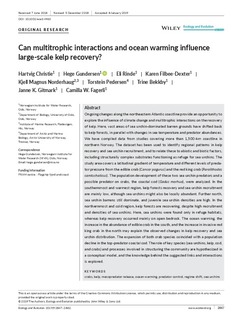| dc.contributor.author | Christie, Hartvig C | |
| dc.contributor.author | Gundersen, Hege | |
| dc.contributor.author | Rinde, Eli | |
| dc.contributor.author | Filbee-Dexter, Karen | |
| dc.contributor.author | Norderhaug, Kjell Magnus | |
| dc.contributor.author | Pedersen, Torstein | |
| dc.contributor.author | Bekkby, Trine | |
| dc.contributor.author | Gitmark, Janne Kim | |
| dc.contributor.author | Fagerli, Camilla With | |
| dc.date.accessioned | 2019-06-26T13:45:12Z | |
| dc.date.available | 2019-06-26T13:45:12Z | |
| dc.date.created | 2019-02-13T14:55:20Z | |
| dc.date.issued | 2019 | |
| dc.identifier.citation | Ecology and Evolution. 2019, 9, 2847-2862. | nb_NO |
| dc.identifier.issn | 2045-7758 | |
| dc.identifier.uri | http://hdl.handle.net/11250/2602394 | |
| dc.description.abstract | Ongoing changes along the northeastern Atlantic coastline provide an opportunity to explore the influence of climate change and multitrophic interactions on the recovery of kelp. Here, vast areas of sea urchin‐dominated barren grounds have shifted back to kelp forests, in parallel with changes in sea temperature and predator abundances. We have compiled data from studies covering more than 1,500‐km coastline in northern Norway. The dataset has been used to identify regional patterns in kelp recovery and sea urchin recruitment, and to relate these to abiotic and biotic factors, including structurally complex substrates functioning as refuge for sea urchins. The study area covers a latitudinal gradient of temperature and different levels of predator pressure from the edible crab (Cancer pagurus) and the red king crab (Paralithodes camtschaticus). The population development of these two sea urchin predators and a possible predator on crabs, the coastal cod (Gadus morhua), were analyzed. In the southernmost and warmest region, kelp forests recovery and sea urchin recruitment are mainly low, although sea urchins might also be locally abundant. Further north, sea urchin barrens still dominate, and juvenile sea urchin densities are high. In the northernmost and cold region, kelp forests are recovering, despite high recruitment and densities of sea urchins. Here, sea urchins were found only in refuge habitats, whereas kelp recovery occurred mainly on open bedrock. The ocean warming, the increase in the abundance of edible crab in the south, and the increase in invasive red king crab in the north may explain the observed changes in kelp recovery and sea urchin distribution. The expansion of both crab species coincided with a population decline in the top‐predator coastal cod. The role of key species (sea urchins, kelp, cod, and crabs) and processes involved in structuring the community are hypothesized in a conceptual model, and the knowledge behind the suggested links and interactions is explored. | nb_NO |
| dc.language.iso | eng | nb_NO |
| dc.publisher | Wiley | nb_NO |
| dc.rights | Navngivelse 4.0 Internasjonal | * |
| dc.rights.uri | http://creativecommons.org/licenses/by/4.0/deed.no | * |
| dc.title | Can multitrophic interactions and ocean warming influence large-scale kelp recovery? | nb_NO |
| dc.type | Journal article | nb_NO |
| dc.type | Peer reviewed | nb_NO |
| dc.description.version | publishedVersion | nb_NO |
| dc.rights.holder | © 2019 The Authors. | nb_NO |
| dc.source.pagenumber | 2847-2862 | nb_NO |
| dc.source.volume | 9 | nb_NO |
| dc.source.journal | Ecology and Evolution | nb_NO |
| dc.identifier.doi | 10.1002/ece3.4963 | |
| dc.identifier.cristin | 1677061 | |
| dc.relation.project | Norsk institutt for vannforskning: NIVA-prosjekt: 10461 | nb_NO |
| dc.relation.project | Norges forskningsråd: 188955 | nb_NO |
| dc.relation.project | Norges forskningsråd: 255085 | nb_NO |
| dc.relation.project | Norges forskningsråd: 160016 | nb_NO |
| dc.relation.project | Norges forskningsråd: 280732 | nb_NO |
| dc.relation.project | Framsenteret: ? | nb_NO |
| cristin.unitcode | 7464,20,11,0 | |
| cristin.unitcode | 7464,20,0,0 | |
| cristin.unitname | Marin biologi | |
| cristin.unitname | Fagsenter for kyst- og havmiljø | |
| cristin.ispublished | true | |
| cristin.fulltext | original | |
| cristin.qualitycode | 1 | |

